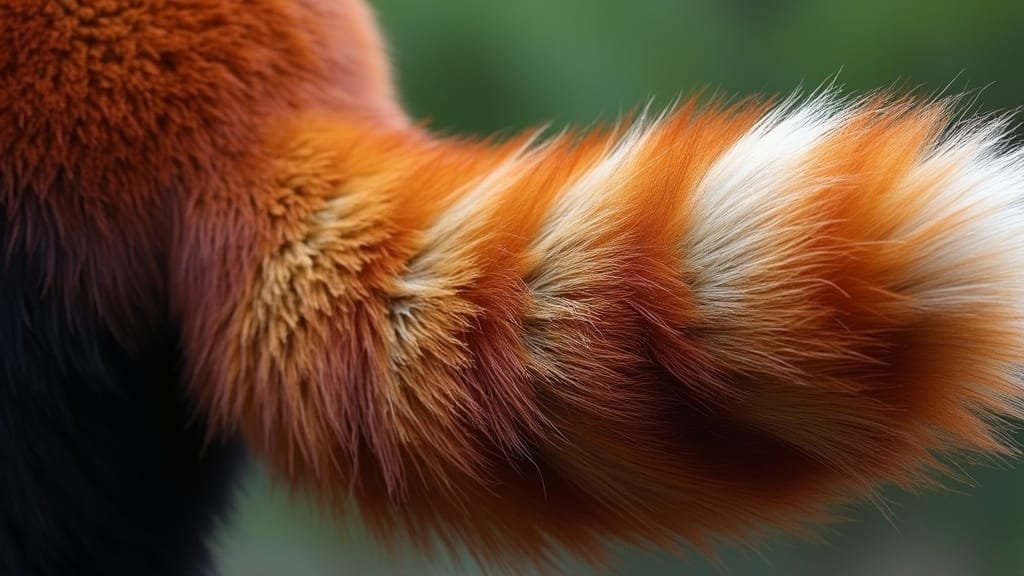Red pandas are not only known for their adorable appearance but also for their long, bushy tails, which play an essential part in their survival. These tails, measuring 12–20 inches, are almost as long as their bodies and are covered with alternating red and white rings. Beyond their striking appearance, red panda tails serve multiple purposes, including helping them balance while climbing, providing insulation during cold Himalayan winters, and even acting as a camouflage tool to evade predators
In this article, we’ll explore the unique physical features of red panda tails, how they use them for survival, and the evolutionary adaptations that make these tails indispensable for life in the trees
Unique Physical Features of Red Panda Tails

The tail of the red panda is a distinctive feature that sets it apart from other mammals. With its bushy fur, unique coloration, and impressive length, the tail is perfectly adapted to support the red panda’s arboreal lifestyle and survival in cold environments
Length, Flexibility, and Ringed Pattern
The red panda’s tail is remarkably long, measuring between 12 and 20 inches, nearly equal to the length of its body. This length provides a significant advantage for balance as the red panda moves along narrow tree branches or climbs to reach food. The tail’s flexibility ensures that the red panda can adjust its movements precisely, helping it maintain stability even in precarious positions
A unique aspect of the red panda’s tail is its alternating red and white rings, which mimic the light and shadow patterns of the forest canopy. According to Choudhury (Journal of Zoology, 2001), this pattern enhances the red panda’s ability to remain concealed from predators, such as snow leopards and eagles, when viewed from below
Bushy Fur and Its Multiple Functions
The tail is covered in thick, bushy fur that serves several important purposes. In addition to providing warmth, the dense fur protects the tail from wear and tear as the red panda moves through its rugged environment. The fur also plays a role in water resistance, helping to repel snow and rain and keeping the tail dry in wet conditions
Field research by Yonzon et al. (Biological Conservation, 1987) observed that red pandas frequently wrap their tails around their bodies when sleeping to conserve heat. This behavior demonstrates how the bushy texture of the tail is finely adapted for thermoregulation in their cold Himalayan habitat
Comparison to Other Mammals’ Tails
While other tree-dwelling mammals, such as raccoons and lemurs, also have tails that aid in balance, the red panda’s tail stands out for its multi-functionality. Raccoons, for example, have shorter tails that are less effective for providing insulation, while lemurs’ tails lack the thick fur necessary for surviving in freezing conditions
The red panda’s tail is more similar to that of Arctic foxes, which also rely on bushy tails for warmth during rest. However, the red panda’s tail is uniquely adapted to its arboreal lifestyle, combining traits of balance, camouflage, and insulation in a single feature. Roberts and Gittleman (Mammalian Biology, 2020) concluded that the red panda’s tail is one of the most versatile adaptations among small mammals living in cold, forested environments
How Red Pandas Use Their Tails for Survival

The red panda’s tail is more than just an aesthetic feature—it is a vital tool that supports its survival in the harsh environments of the Himalayan mountains. From balancing in the trees to providing warmth and protection, the tail is an indispensable part of the red panda’s daily life
Balancing During Climbing and Feeding
Red pandas spend most of their time in the trees, navigating narrow branches in search of food such as bamboo. Their long, flexible tails act as a counterbalance, allowing them to maintain stability while climbing or stretching to reach leaves at the tips of branches
Yonzon et al. (Biological Conservation, 1987) observed that red pandas rely heavily on their tails for balance, particularly when feeding in precarious positions high above the ground. The tail’s length and lightweight structure make it ideal for arboreal movement, helping the red panda avoid falls in its challenging habitat
Additionally, the tail enhances the red panda’s ability to descend trees headfirst, a skill that requires precise control and stability. Without their tail for balance, red pandas would struggle to maneuver as effectively in their tree-dwelling lifestyle
Insulation in Freezing Temperatures
The thick, bushy tail of the red panda serves as a natural blanket during cold Himalayan winters, where temperatures can drop below freezing. When resting or sleeping, red pandas curl into a ball and wrap their tails around their bodies, covering their face, nose, and paws to retain warmth
Pradhan et al. (Journal of Mammalogy, 2001) documented this behavior, noting that the tail significantly reduces heat loss in vulnerable areas such as the extremities. This adaptation allows red pandas to conserve energy, which is especially important given their bamboo-based diet, which provides limited calories
The tail’s dense fur also protects it from the elements, repelling snow and rain to keep the red panda dry and warm in wet conditions. This dual function of insulation and weather resistance makes the tail a critical survival tool in the cold, high-altitude forests the red panda calls home
Camouflage for Predator Avoidance
The tail’s alternating red and white rings help the red panda blend seamlessly into the forest canopy, providing effective camouflage against predators such as snow leopards and birds of prey. The ringed pattern mimics the dappled light and shadows of the forest, making the red panda difficult to spot from both above and below
According to Choudhury (Journal of Zoology, 2001), this camouflage strategy is particularly effective when the red panda is resting motionless on tree branches. Combined with its ability to stay still for long periods, the tail’s coloration reduces the likelihood of detection by visually-oriented predators
Additionally, red pandas use their tails for signaling during encounters with potential threats. A raised or wagging tail can indicate alertness or agitation, serving as a warning to other red pandas or an attempt to deter predators
For further insights into how red pandas use their tails for survival, refer to the WWF resource on red panda facts
Communication and Evolutionary Adaptations of Red Panda Tails

The red panda’s tail is not just a physical adaptation for survival but also plays a role in communication and reflects its evolutionary history. This unique feature demonstrates how red pandas have adapted to their arboreal lifestyle and the challenges of their environment
Using Tails for Non-Verbal Communication
Red pandas use their tails as a tool for non-verbal communication during social interactions. For example, a raised or flicking tail can signal alertness, agitation, or a defensive posture when encountering threats. During territorial disputes, the tail may be used as part of an intimidation display, helping red pandas establish dominance or deter rivals
Additionally, the tail can act as a visual signal during courtship or interactions with other red pandas. While vocalizations are relatively rare in red pandas, their tails play a subtle but effective role in expressing their mood and intentions
Behavioral studies by Yonzon et al. (Biological Conservation, 1987) noted that red pandas frequently incorporate tail movements into their social behaviors, emphasizing the tail’s importance beyond physical survival
Evolution of the Tail for Arboreal Living
Over millions of years, red pandas have evolved their tails to suit their arboreal lifestyle. The tail’s length and flexibility are essential for maintaining balance on narrow branches, while its bushy texture provides protection from cold temperatures. These traits have allowed red pandas to occupy a unique ecological niche as tree-dwelling herbivores in the high-altitude forests of the Himalayas
According to Roberts and Gittleman (Mammalian Biology, 2020), the red panda’s tail has adapted to serve multiple functions, a feature that enhances its fitness in a challenging environment. The evolution of its ringed pattern, in particular, provides a significant advantage by improving camouflage, reducing visibility to predators
Regional Variations in Tail Features
Red pandas living in different regions may exhibit subtle differences in the thickness and length of their tails, reflecting the environmental conditions of their specific habitats. For example, populations living at higher altitudes, such as those in Nepal and Bhutan, tend to have bushier tails compared to those in lower-altitude regions of China. This variation likely evolved as a response to colder climates, where additional insulation is necessary
Studies comparing red panda populations, such as those by Wei et al. (Journal of Mammalogy, 2014), have found that these regional adaptations highlight the flexibility of the species in responding to environmental pressures. These differences in tail features allow red pandas to thrive across a wide range of habitats within their geographic range
For more information on the evolutionary significance of red panda tails, visit the Redwood Zoo’s article on red panda facts













